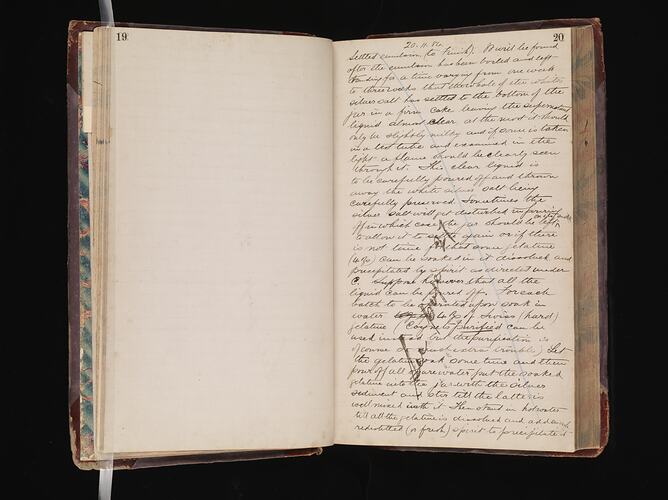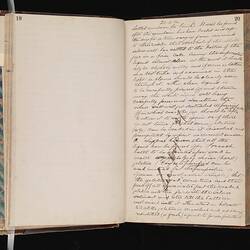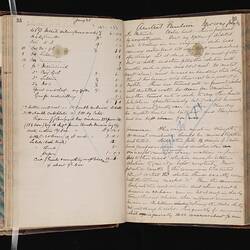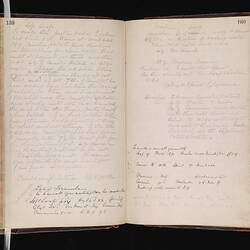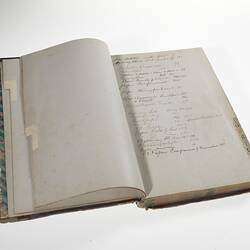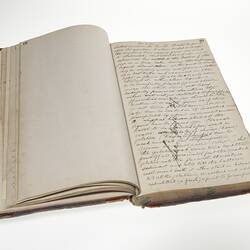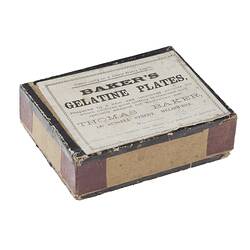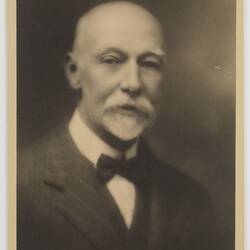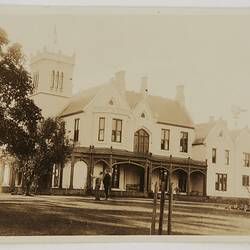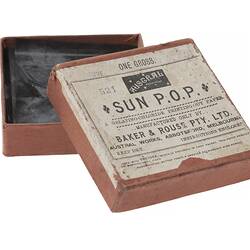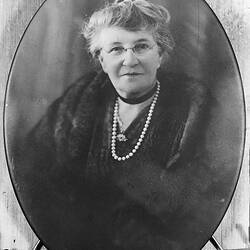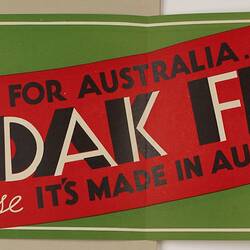Summary
Photographic emulsion formulae book created by Thomas Baker at his photographic laboratory in Abbotsford, from 1884 to 1921.
This book covers the time period beginning with the establishment of Baker's photographic product manufacturing business, the Austral Plate Company in 1884, and continues as the business expanded and evolved through various name changes, including Thomas Baker & Company, Baker & Rouse Pty Ltd, Kodak (Australasia) Limited and Kodak Australasia Pty Ltd. It is a highly significant artefact of Australia's early photographic industry.
The book contains the original chemical formulae and associated detailed instructions for making a variety of photographic goods, including emulsions for glass plates, photographic papers, x-ray products, toning and fixing products. These 'recipes' were used in Baker's highly successful photographic product manufacturing business, for items such as Sun Paper, Austral Emulsion, and Gaslight Pearl Paper. The book consists of an index at the front, referring the reader to a wide variety of instructions and formulae. Handwritten by Baker, the book shows his careful experimentation and is witness to the development of his photo-chemical expertise over time. Formulae from early periods are neatly crossed out with directions to the newest, updated formula. The book also includes discussion of manufacturing problems that required improved chemistry or handling solutions, and noted the costs of some processes, such as coating glass plates.The book bears evidence of Baker's chemical experimentation, with emulsion droplets containing mercury, lead and silver in trace amounts still evident on some pages.
The earliest entry was made on 20 November 1884, and was for making 'settled' emulsion, intended for the 'finishing process', in preparation for coating onto glass plates. This recipe was later crossed out in favour of an 1886 recipe for 'finishing the emulsion'. The latest entry is from November 1921, for X-Ray Plates.
Physical Description
Ledger book bound in cloth with leather corners and leather strip near spine, and with card inserts inside the covers. The inside binding has five staples and white cloth along the spine. Inside frontispieces have marbled paper and the edges of the papers are also marbled. The book contains an A-Z index at the front with cut-out tabs, followed by 518 lined pages. The pages contain handwritten entries, in pencil and different coloured ink. A number of pages are blank. Several pages have spots of emulsion. Page 34 has been tested and is known to contain traces of mercury, lead and silver. The binding on the spine has been lost. Page G of index is loose from the binding. Several loose sheets are inserted, such as between pages 307-308 (dated 8/2/1912), 321-322 (printed Emulsion batch information sheet, ripped in half, with some handwritten annotations), 339-340 (handwritten Pyro Soda Developer formula 2121), 377-378 (printed sheet of Australian Kodak Ltd letterhead with illustration), 395-396 (plate coating notes)
Significance
This formulae book, created by Australian photographic manufacturing pioneer Thomas Baker, is an immensely significant artefact of Australia's early photographic industry, and a treasure of the Kodak Heritage Collection. It has national significance, for both photo history and local manufacturing history. The book traces the evolution of the photo-chemical formulae developed by Thomas Baker over the first few decades of his photographic product manufacturing business - innovative and precise chemical recipes that were the keystone of his company's success, developed at the very beginnings of Australia's homegrown photographic product industry. Baker's work was so successful that within the period of this formulae book's life, his business was merged into Kodak, the world leader in photographic product manufacturing. This book is a rare artefact from the early period of Australasian photo manufacturing, and represents the chemistry basis that defined silver halide based photography for over one hundred and fifty years, but which has now been largely rendered obsolete by the emergence of digital imaging technologies. It is a fascinating resource, and will be of interest to those people interested in the composition of silver halide chemistry, as detailed formulae of photographic emulsions are rarely available. It is also highly evocative as an artefact, holding traces of the very formulae it details in its pages, with spots of mercury, lead and silver evident on several pages, and bringing the process of making emulsions very much to life.
More Information
-
Collection Names
-
Collecting Areas
-
Acquisition Information
Donation from Kodak (Australasia) Pty. Ltd., 23 Apr 2013
-
Place & Date Created
Abbotsford, Greater Melbourne, Victoria, Australia, 1884-1921
-
Creator
Mr Thomas Baker - Austral Plate Company, Abbotsford, Greater Melbourne, Victoria, Australia, 1884-1887
-
Creator
Austral Plate Company, Abbotsford, Greater Melbourne, Victoria, Australia, 1884-1887
Date range is for the time period that the company operated under this name. -
Creator
Baker & Rouse Pty Ltd, Abbotsford, Greater Melbourne, Victoria, Australia, 1897-1908
Date range is for the time period that the company operated under this name. -
Creator
Kodak (Australasia) Limited, Abbotsford, Greater Melbourne, Victoria, Australia, 1911-1913
Date range is for the time period that the company operated under this name. -
Creator
Kodak (Australasia) Pty Ltd, Abbotsford, Greater Melbourne, Victoria, Australia, 1920-1921
-
Inscriptions
Various and multiple handwritten inscriptions on most pages - see digitised copies of each page in the book for details of content.
-
Classification
-
Category
-
Discipline
-
Type of item
-
Overall Dimensions - Closed
216 mm (Width), 31 mm (Depth), 335 mm (Height)
-
Keywords
Chemistry, Photography, Manufacturing, Research, Photographic Processes, Photographic Developers, Photographic Equipment & Supplies, Photographic Supplies, Chemistry Laboratories, Photographic Papers, Making History - Kodak Collection
